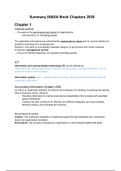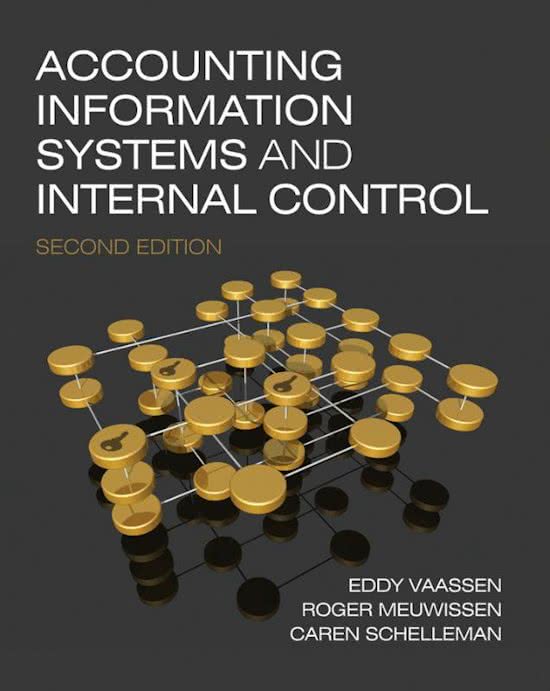Summary IS&DA Book Chapters 2020
Chapter 1
Internal control
→ Focuses on the governance and control of organizations
And therefore, on managing people
The applicable instruments are predominantly mechanistic by nature and do not pay attention to
problems stemming from employees etc.
However, now there is a completely separate category of governance and control measure
introduced: management control
→ Focus on informal measures, for example motivating people
ICT
Information and communication technology (IT) can be defined as:
All the electronic media used to input, process, and store data, to provide information, and to
support or enable communication.
Information system: hard + software that for inputting, storing and processing that data into
meaningful information
Accounting Information System (AIS)
An AIS is an organized collection of software and hardware for inputting, processing and storing
data of business events, aimed at:
- Providing information to internal and external stakeholders that complies with specified
quality dimensions
- Creating the right conditions for effective and efficient delegation and accountability,
decision-making, and operating the business.
Governance & control
Control: The continuous realization of legitimized goals through deliberate and cooperative
actions by organization members.
Governance: The process of keeping an organization on track towards legitimized goals.
,Information-based control framework
→ Can be used to describe, analyze and solve AIS problems.
The eight cells need to be continuously aligned with one another for optimal problem solutions.
→ This also means that a change in one cell always will lead to changes in another cell.
Control concepts overlaid onto the framework
● Strategic control:
The process aimed at formulating the right strategy, given the specific circumstances of an
organization.
● Management control:
The managerial activities that are aimed at having employees behave in accordance with
the organization’s objectives.
● Internal control:
A process, effected by an entity’s board of directors, management, and other personnel,
designed to provide reasonable assurance regarding the achievement of objectives relating
to operations, reporting, and compliance.
,● Information control:
Internal control aimed at the information provision of an organization.
● Data control:
Internal control aimed at the data management of an organization.
● IT control:
Internal control aimed at the IT infrastructure of an organization.
Quality
The quality dimensions that apply to each of the cells in the information-based control
framework:
● Quality of operations
Four dimensions:
- Efficiency and effectiveness of internal processes
- Innovative power
- Customer satisfaction
- Financial performance
● Quality of information
Focus on the degree to which information can be used for delegation and accountability,
decision making and operating the business.
Info is reliable if it is valid, accurate and complete
Info is relevant if it has the desired level of precision, is provided on time, and
understandable by the user.
→ Together this is effective
, ● Quality of data
Focus on the degree to which data can be used for effective and efficient information
provision.
Transaction vs master data
Transaction data → Related to the input validity, input accuracy and input completeness
Master → Related to the update accuracy and the update completeness






